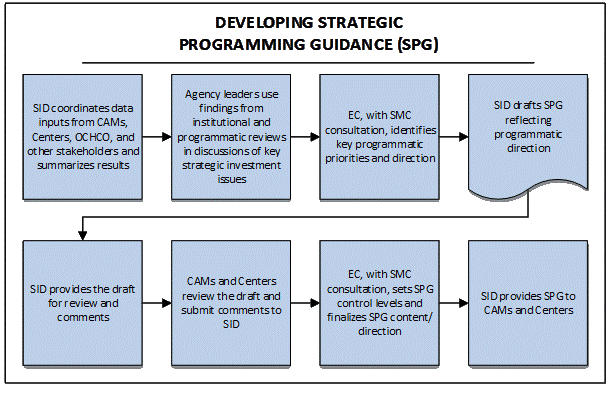
Procedural
Requirements
Effective Date: September 07, 2016
Expiration Date: September 07, 2026

|
NASA Procedural Requirements |
NPR 9420.1A Effective Date: September 07, 2016 Expiration Date: September 07, 2026 |
| | TOC | ChangeLog | Preface | Chapter1 | Chapter2 | Chapter3 | Chapter4 | Chapter5 | Chapter6 | AppendixA | AppendixB | AppendixC | AppendixD | AppendixE | ALL | |
2.1.1 NASA's budget planning activities are complex and take into consideration many internal and external factors that affect the Agency. Economic, political, social, and technological conditions can represent trends, threats, and opportunities that affect not only the work that NASA does but also how the Agency does it. The planning phase of the annual budget formulation cycle requires leaders and managers to consider how the Agency will adjust to these changing conditions and what programming strategies will yield the best outcomes. Early in the planning phase, the Administration provides top-level guidance and programmatic priorities to which the Agency will respond. Senior leaders will consider the Agency's desired longer-term strategic goals, multi-year outcomes, and may revise shorter-term goals. The Office of Strategy and Plans informs senior leadership on the strategic impact of the changing conditions through targeted meetings hosted by the Associate Administrator to ensure enterprise leadership and management.
2.2.1 Purpose. The SPG provides initial budget formulation guidance and assumptions for the five-year budget horizon. It also communicates any changes in Administration priorities and policy. It includes a preliminary budget formulation schedule, programmatic roles and funding levels, workforce planning guidance and targets, estimates of institutional capabilities and requirements, guidance for Program and Resource Guidance (PRG); instructions for Program Analysis and Alignment (PAA) reports, and other assumptions necessary to develop budget estimates. CAMs use the SPG to make determinations on how investments will best enable the Agency to pursue its strategic goals, given certain budget conditions and constraints.
2.2.2 Process. OCFO will collect information from stakeholders and develop budget formulation guidance. The Senior Management Council (SMC) advises the EC, and the EC provides unique guidance. Refer to Figure 2, SPG Process.
2.2.3 Timeline. SPG content is dependent on the public release of budget and policy information in the PBR from the prior budget cycle. To expedite the start of the budget formulation process, OCFO SID finalizes the SPG for release on the same date or as soon as possible after the public release of the PBR. Typically, the PBR and SPG are released in February, but if the PBR is delayed then the SPG release is usually delayed as well.
2.2.4 Responsibilities
2.2.4.1 OCFO SID. develops and releases the SPG and schedule, given inputs from stakeholders. OCFO SID defines the requirements for tracking and justifying required adjustments to SPG resource totals.
2.2.4.2 OCHCO provides input to the workforce planning process, including priorities for workforce planning, milestones, and deliverables.
2.2.4.3 CAMs provide input and issues relevant to SPG development and provide comments to draft documents.
2.2.4.4 OCFO BD/Center CFOs, and Mission Support Offices provide to OCFO SID issues and supporting information to be addressed in the SPG.
2.2.4.5 The EC< provides final reviews of the SPG before its released.
2.2.5 SPG Considerations.
a. SPG tables typically include current execution year account funding levels. If a current-year appropriation has been passed by the time the SPG is released, the SPG account funding levels will reflect appropriated levels. If a current-year appropriation has not been passed (for example, if the Agency is operating under a Continuing Resolution (CR), the EC will provide guidance on what account funding levels to assume for the current execution year in the SPG.
b. The initial FTE and work-year equivalent (WYE) workforce resource guidelines are a starting point for CAM analysis and identification of issues to be resolved during budget formulation. They are considered preliminary, not final.
c. The SPG may include information on unresolved OMB settlement requirements from the prior budget year, strategic and performance reviews, and recommendations from the annual Agency Strategic Implementation Planning (ASIP) review. See NPD 1000.0 and NPD 1000.5.
d. The SPG will include guidance for known commitments and liabilities, when applicable (e.g., Agency Baseline Commitment for major projects, clean up liabilities, and contract termination costs).
e. The SPG generally does not dictate tactical approaches or targets for achieving NASA-specific or broader Administration or Congressional objectives. CAMs generally have discretion over within-account programming decisions.

Figure 2, SPG Process
| TOC | ChangeLog | Preface | Chapter1 | Chapter2 | Chapter3 | Chapter4 | Chapter5 | Chapter6 | AppendixA | AppendixB | AppendixC | AppendixD | AppendixE | ALL | |
| | NODIS Library | Financial Management(9000s) | Search | |
This document does not bind the public, except as authorized by law or as incorporated into a contract. This document is uncontrolled when printed. Check the NASA Online Directives Information System (NODIS) Library to verify that this is the correct version before use: https://nodis3.gsfc.nasa.gov.